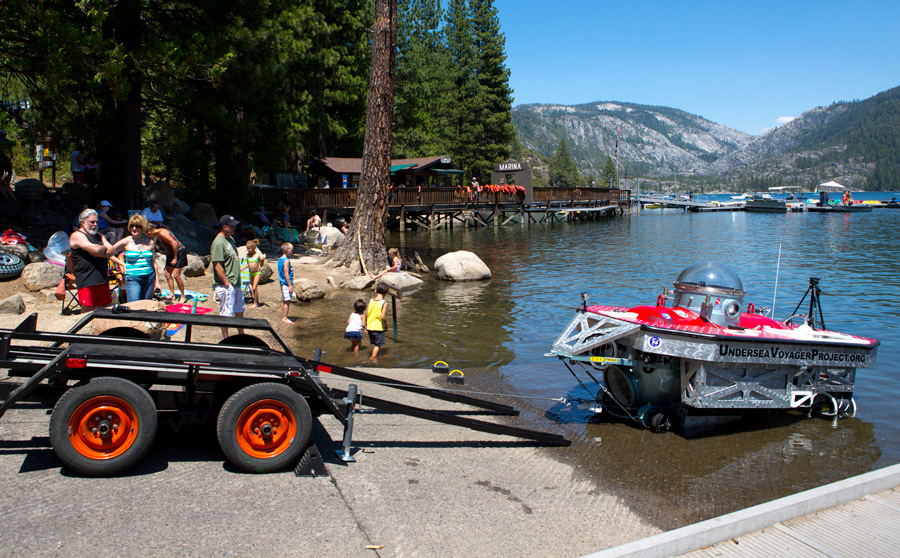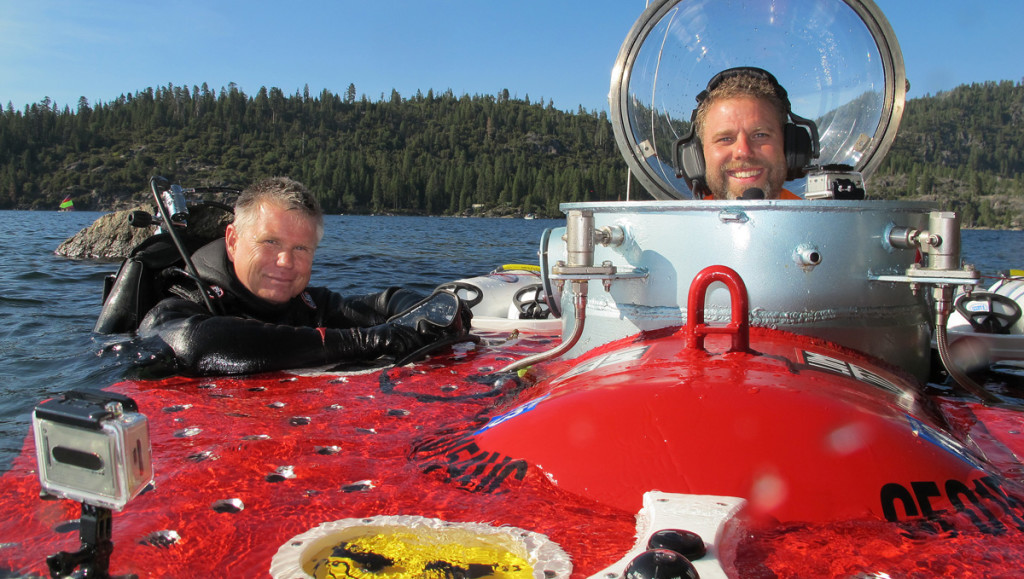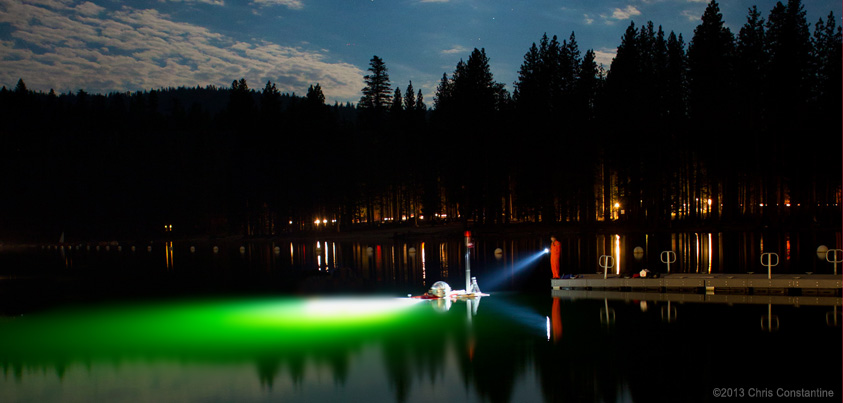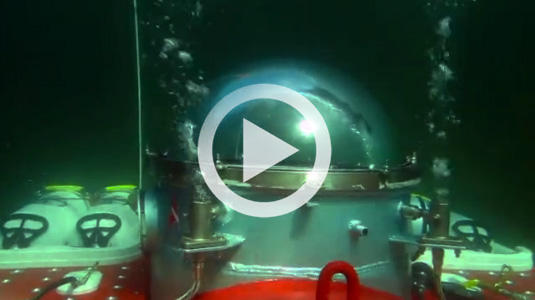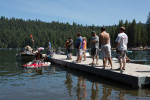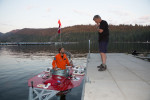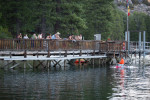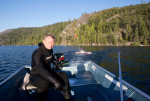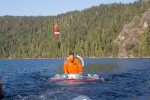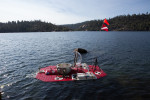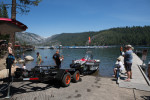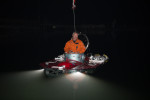Drive 3 hours inland, ascend 5,500 feet in elevation, and you’ve just found the ideal place to launch your own 2-person research submarine.
The Undersea Voyager Project’s President Scott Cassell and Chief Engineer and pilot Scott Reed did just that this July, and have now completed their final test dives in the “Great White” – the Undersea Voyager Project Project’s own submarine. After an extensive redesign and upgrade of the electronics, communications, thrusters and ballast systems, the Great White has completed her shakedown dives at Pinecrest Lake, and is now being shipped to Singapore on her first mission since the latest modifications. Prior test dives this summer also took place at Lake Tahoe.
Story, photos and video by Chris Constantine
Building the Great White
The Great White (nicknamed “spots”, after one of Scott C.’s favorite sharks recently killed by poachers in Mexico) started as a rusted steel hull rotting in a backyard when it was rescued by Scott Cassell and Tom Mix. It was originally built back in the 1960’s, and when Scott and Tom discovered it, it was not much more than an empty, rusty shell. 6 years of rebuilding, hundreds of hours and thousands of dollars later, she was finally undersea-worthy again and was once again an official submarine. On January 15th, 2012, in King Harbor, Redondo Beach a dedicated group of volunteers put the Great White back in the ocean for the first time in over 17 years.
The sub has been seen on tour at many dive shows and shown most recently at the Maker Faire in San Mateo. It was here in 2012 where Scott Cassell met Scott Reed, who was so intrigued and inspired that he donated his engineering and fabrication skills (totaling hundreds of hours over 10 months) to complete the latest fabrications and upgrades. In addition to installing new electronics, communications, and scientific testing equipment, the sub now carries enough air to provide up to 72 hours of life support, although most dives will be far shorter than that. In an unmanned test dive in Lake Tahoe, the Great White successfully reached a depth of 500 feet.
The Great White is both unique in functionality and striking in appearance, and the craftsmanship on the Great White is impeccable. At each launch, crowds gathered dockside to see the sub and ask questions, to which Scott C. and Scott R. are pleased to answer. Towing the submarine on its custom-built trailer gets similar looks on the highway.
An Ideal Alpine Test Site
Built during the logging era of 1914, Pinecrest lake was built to provide drinking water to the lower elevations and generate power through the power house downstream at Spring Gap. The lake is now a popular summer recreation destination, with a large camping area, cabins rentals, and sailboat and powerboat rentals. It’s also an ideal testing location for the Great White due to its close proximity to Scott Reed’s shop in Soulsbyville where the Great White has been upgraded, just 20 miles west. Additionally, Pinecrest lake offers easy dock access, clear water, and the depth needed for testing.
When filled to capacity, Pinecrest lake reaches 165 feet deep, however the final test dives here were to 30-60 feet deep (deeper tests had already been completed at Lake Tahoe). Visibility on the final test day was approximately 40 feet – not as clear as Lake Tahoe, but more than adequate for testing purposes. As is typical in most lakes, there was an abrupt 15-20 degree temperature change at the thermocline. Inside the sub, Scott Reed welcomed the cooler water after being exposed to the 85 degree temperatures and bright sunlight at the surface.
Operating on both sides of the thermocline and in relatively shallower waters require very precise adjustments for the pilot. As in scuba diving, there are significant buoyancy changes in the top 33/34 feet which require careful and continuous adjustments in buoyancy. For a diver, adding and venting air from the BC prevents the diver from crashing into the bottom or rising quickly to the surface; the same principles apply to the Great White. A strong thermocline here also created some difficulties with their acoustic communications – the thermocline creates a barrier and makes acoustic communications difficult between the sub and outside divers who accompanied the sub to evaluate its systems and help direct the Great White’s course.
The Great White’s Final Test Day
After a mid-afternoon arrival and launch, the Great White was towed south across Pinecrest Lake to an area which offered deeper water, a shoreline staging area, and a bit of distance from the many boaters on the lake. On this day, Scott Cassell and I donned our SCUBA gear to accompany the Great White underwater, and Scott Reed manned the sub for two 30-45 minute test dives.
Once in the water and at the dive location, Scott Reed readied the Great White for diving with a final safety check and locking the clear dome in place. Two rear electric thrusters moved the sub offshore a bit into water 20 feet deep, and with the turn of two valves, the ballast tanks were emptied of air and the Great White slowly submerged and gently descended to the bottom.
The Great White is propelled forward, backward, and sideways with electric thrusters which look similar in appearance to electric trolling motors on a fishing boat, and several large rechargeable batteries provide the power for both the thrusters and all onboard electronics. With the turn of a joystick, Scott R. can easily control the speed and direction of the Great White in any direction, white the ascent and descent is controlled with both a top thruster and ballast tanks. Underwater, the Great White moves effortlessly and gracefully.
From inside the sub, the pilot views the undersea world through a large port on the front (while laying down inside), through the large dome on top, or with two monitors fed by cameras mounted outside the sub (Scott hopes to be able to extend the height of the top dome for greater visibility with help from his Kickstarter campaign). Topside communications are done via VHF radios; when underwater an acoustic communications system is used.
While the controls are very logical and intuitive in nature (thanks in part to Scott Cassell’s extensive undersea experience and Scott Reed’s engineering), it takes practice, practice, and more practice to be able to operate a submarine with precision, which is another reason these test dives were made. Every added component on the Great White slightly alters the buoyancy and handling characteristics; even the weight of the pilot requires planning and adjustments.
After the two successful test dives on this day, the Great White was towed back to the Pinecrest Marina dock area for some night dives. By this time (7:30pm), most of the recreational boaters were off the lake and we were able to operate right off the boat dock – an ideal staging area.
At night, the DeepSea Power & Light bright LED lights do an incredible job lighting up the water (these lights are also used at depth during daytime when needed). On this evening, 4 more dives were made at the dock area, all with complete success. At 11pm, the Great White was loaded back on her trailer for a final day in the shop before being shipped overseas for her next mission.
The next stop for the Great White will be in Singapore, where Scott C. and Scott R. will be conducting underwater surveys of the reef habitat, and taking government officials on dives to show them, firsthand, the underwater environment. Scott Cassell is a fierce advocate for the ocean and sharks, in particular, and the completion of the Great White adds an important educational tool for teaching others about the ocean and humankind’s important role in protecting her.
Becoming a part of the Undersea Voyager Project
The Undersea Voyager Project is a non profit (501-c-3) public-benefit company for Oceanic Research and Educational Outreach. Founded by undersea explorer Capt. Scott Cassell, the Undersea Voyager Project utilizes manned submersibles to take a physical look at the first 100-1,000 feet of seawater, (which is the largest environment on Earth) on a continuing series of missions to explore the Earth underwater. UVP is privatizing ocean exploration and science by inviting the public to participate. Anyone can become a part of the Underwater Voyager Project by donating, participating, or helping to promote their cause. Scott encourages people from all ages and walks of life to participate, and even learn to become a pilot in the Great White.
The Undersea Voyager Project’s Youth Ambassador Program designed to recruit and train kids ages 14 to 19 in the basics of scientific and oceanic exploration. Real world opportunities to travel and learn are paired with the requirement to give at least one speech a year to their peer groups. More information on the UnderseaVoyager Project can be found on their website at underseavoyagerproject.org.
The Underwater Voyager Project exists thanks to generous sponsors who support Scott Cassell, the Great White, and all of the Undersea Voyager Project’s missions. In particular, Luminox has been a key partner and in addition to providing funding has also created the new 3954 Colormark Special Scott Cassell dive watch. A portion of proceeds from sales of this watch will go toward funding the Undersea Voyager Project and its mission of exploration. In addition, Luminox and Scott Cassell also created the new 1525 Deep Dive Special watch. Other sponsors of the Undersea Voyager Project include DeepSea Power & Light, Blue Steel Scuba, The Roddenberry Foundation, Fourth Element, SEAmagin, Submersible Systems Inc., VR Technology, Ansell Protective Solutions, In Depth International, Inc., and Ocean Technology Systems (OTS).


Story, photos and video by Chris Constantine.
©2013 California Diver Magazine. Content may not be used in any form without prior express permission.

